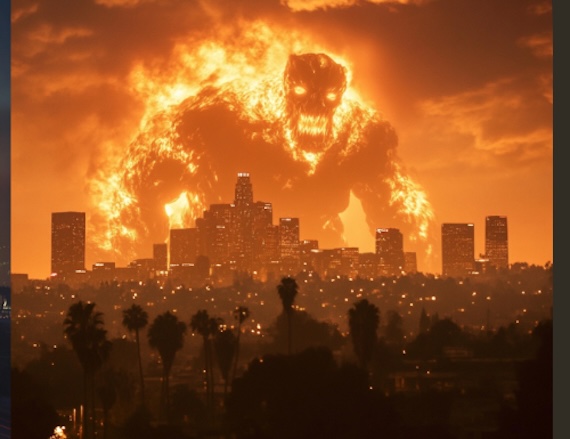Ann Arbor (Informed Comment) – The Los Angeles wildfires destroyed over 1,000 buildings, forced thousands from their homes, and left at least five dead as of this writing. The Pacific Palisades fires destroyed many historic structures, including the home of legendary comedian and actor Will Rogers (d. 1935). Reading some of his quotes, I conclude that the sorry episode would not have surprised him in the least. People who know me know that I have a California dimension — my father was stationed out there on a couple of occasions in the army, and I did a degree at UCLA. I’m devastated. Some of my friends had to flee their homes.
As the experts quoted by Matt McGrath at the BBC point out, climate change certainly played a role in the destruction of Pacific Palisades and Altadena yesterday in Los Angeles, though its precise effect has yet to be calculated.
He cites the Director of the Centre for Wildfire Research at Swansea University, Professor Stefan Doerr, saying, “While fires are common and natural in this region, California has seen some of the most significant increases in the length and extremity of the fire weather season globally in recent decades, driven largely climate change.”
Doerr goes on to caution that the precise contribution of human-caused climate change to yesterday’s conflagration has yet to be estimated. Still, the only question is how much our carbon dioxide and methane emissions turbocharged the wildfires, not whether they did. Was it by 10% or 30%? There is some indication it could have been by 40%! (See below).
Climate is long-term weather patterns. Weather is a one-off. A two-day downpour can be weather. A long-term increase in rainfall over previous averages would be climate change.
The ways in which weather contributed to the Los Angeles catastrophe are easier to specify. California had a twenty-year drought that ended two years ago. The plentiful rainfall since then caused a lot of shrubs and greenery to spring up. Then, this spring, summer and fall turned extremely dry. The December rains did not come. Usually there would have been 4 inches by early January. It was under an inch. That water would have tamped down the fire risk. Then, the Santa Ana winds blowing west through the mountains were unusually strong and hot, and hit places they usually missed.

“Blaze Stalks L.A.,” Digital, Midjourney, 2024.
But why has this year been so dry, creating abundant “fuel” for the wildfire demons?
Daniel Swain, a climate scientist at UCLA, pointed in a scientific paper to the way in which burning fossil fuels and putting carbon dioxide into the atmosphere has caused more frequent dry autumns, and caused them to be drier for longer. Since the Santa Ana winds hit in fall and winter, if the dry season is extended, it increasingly overlaps with the winds. That is a recipe for disaster, as we just saw. Swain cites another study of the years 1960 – 2019 showing that November has gotten consistently drier over the past 60 years. We saw that again this fall. But it wasn’t weather, since there is a clear pattern of desiccation in the 11th month. It is climate.
Worse, Swain thinks we may see more and more of this deadly overlap as humans heat up the earth.
He also cites studies showing that winter rains may be concentrated later in the year. You could have some showers in October in the old days, and November could be wet. Increasingly, those months are dry, and rains fall December through February, maybe especially January-February.
I’ve long noticed how much it rains in the Raymond Chandler mysteries set in Los Angeles. Except for February, I don’t remember it being that rainy, cool and miserable in L.A. At first I thought it was because Chandler was British and he was importing his weather imagery to southern California. But after reading Swain I wonder if the rain wasn’t just spread out more in the 1930s and 1940s, and whether there didn’t used to be more of it.
As for the percentage by which human-caused climate change has ramped up the dangers, we have a study that suggests a particular number. A 2022 paper by Linnia R. Hawkins et al. subjected the teens of this century to a computer study comparing the current likelihood of autumn wildfires in southern California, northern California and Oregon to what it would be without human-caused climate change. They found a 40% increase in the likelihood:
- We show that while present-day anthropogenic climate change has . . . increased the likelihood of extreme fire weather indices by 40% in areas where recent autumn wind-driven fires have occurred in northern California and Oregon. The increase was primarily through increased autumn fuel aridity and warmer temperatures during dry wind events. These findings illustrate that anthropogenic climate change is exacerbating autumn fire weather extremes that contribute to high-impact catastrophic fires in populated regions of the western US.
The authors, however, cite literature that does not find a strong climate change effect for changes in the Santa Ana winds. It is possible that those 100-mile-an-hour gales hitting places they usually don’t, such as Altadena and Pasadena, were just weather. But combined with the shift of rains later in the year and the extra heat and aridity in the fall being driven by climate change, they proved deadly.


 © 2025 All Rights Reserved
© 2025 All Rights Reserved